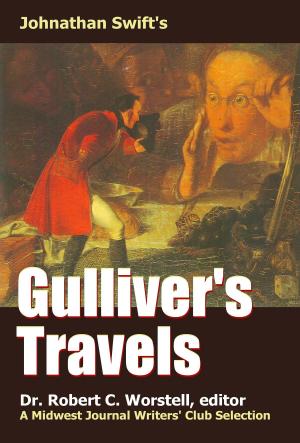| Author: | Jack London | ISBN: | 9781387152490 |
| Publisher: | Midwest Journal Press | Publication: | August 16, 2017 |
| Imprint: | Language: | English |
| Author: | Jack London |
| ISBN: | 9781387152490 |
| Publisher: | Midwest Journal Press |
| Publication: | August 16, 2017 |
| Imprint: | |
| Language: | English |
Tales from the Klondike. Children of the Frost is a collection of short stories first published in 1902. Includes: - The League of the Old Men - In the Forests of the North - The Law of Life - Nam-Bok the Unveracious - The Master of Mystery - The Sunlanders - The Sickness of Lone Chief - Keesh, the Son of Keesh - The Death of Ligoun - Li Wan, the Fair
IN THE FORESTS OF THE NORTH (Excerpt)
A weary journey beyond the last scrub timber and straggling copses, into the heart of the Barrens where the niggard North is supposed to deny the Earth, are to be found great sweeps of forests and stretches of smiling land. But this the world is just beginning to know. The world's explorers have known it, from time to time, but hitherto they have never returned to tell the world.
The Barrens—well, they are the Barrens, the bad lands of the Arctic, the deserts of the Circle, the bleak and bitter home of the musk-ox and the lean plains wolf. So Avery Van Brunt found them, treeless and cheerless, sparsely clothed with moss and lichens, and altogether uninviting. At least so he found them till he penetrated to the white blank spaces on the map, and came upon undreamed-of rich spruce forests and unrecorded Eskimo tribes. It had been his intention, (and his bid for fame), to break up these white blank spaces and diversify them with the black markings of mountain-chains, sinks and basins, and sinuous river courses; and it was with added delight that he came to speculate upon the possibilities of timber belts and native villages.
Avery Van Brunt, or, in full distinction, Professor A. Van Brunt of the Geological Survey, was second in command of the expedition, and first in command of the sub-expedition which he had led on a side tour of some half a thousand miles up one of the branches of the Thelon and which he was now leading into one of his unrecorded villages. At his back plodded eight men, two of them French-Canadian voyageurs, and the remainder strapping Crees from Manitoba-way. He, alone, was full-blooded Saxon, and his blood was pounding fiercely through his veins to the traditions of his race. Clive and Hastings, Drake and Raleigh, Hengest and Horsa, walked with him. First of all men of his breed was he to enter this lone Northland village, and at the thought an exultancy came upon him, an exaltation, and his followers noted that his leg-weariness fell from him and that he insensibly quickened the pace.
The village emptied itself, and a motley crowd trooped out to meet him, men in the forefront, with bows and spears clutched menacingly, and women and children faltering timidly in the rear. Van Brunt lifted his right arm and made the universal peace sign, a sign which all peoples know, and the villagers answered in peace. But to his chagrin, a skin-clad man ran forward and thrust out his hand with a familiar "Hello." He was a bearded man, with cheeks and brow bronzed to copper-brown, and in him Van Brunt knew his kind...
About Jack London:
Jack London (1876-1916), was an American author and a pioneer in the then-burgeoning world of commercial magazine fiction. He was one of the first Americans to make a lucrative career exclusively from writing. London was self-educated. He taught himself in the public library, mainly just by reading books. In 1898, he began struggling seriously to break into print, a struggle memorably described in his novel, Martin Eden (1909). Jack London was fortunate in the timing of his writing career. He started just as new printing technologies enabled lower-cost production of magazines. This resulted in a boom in popular magazines aimed at a wide public, and a strong market for short fiction. In 1900, he made $2,500 in writing, the equivalent of about $75,000 today. His career was well under way. Among his famous works are: Children of the Frost (1902), The Call of the Wild (1903), The Sea Wolf (1904), The Game (1905), White Fang (1906), The Road (1907), Before Adam (1907), Adventure (1911), and The Scarlet Plague (1912).
Tales from the Klondike. Children of the Frost is a collection of short stories first published in 1902. Includes: - The League of the Old Men - In the Forests of the North - The Law of Life - Nam-Bok the Unveracious - The Master of Mystery - The Sunlanders - The Sickness of Lone Chief - Keesh, the Son of Keesh - The Death of Ligoun - Li Wan, the Fair
IN THE FORESTS OF THE NORTH (Excerpt)
A weary journey beyond the last scrub timber and straggling copses, into the heart of the Barrens where the niggard North is supposed to deny the Earth, are to be found great sweeps of forests and stretches of smiling land. But this the world is just beginning to know. The world's explorers have known it, from time to time, but hitherto they have never returned to tell the world.
The Barrens—well, they are the Barrens, the bad lands of the Arctic, the deserts of the Circle, the bleak and bitter home of the musk-ox and the lean plains wolf. So Avery Van Brunt found them, treeless and cheerless, sparsely clothed with moss and lichens, and altogether uninviting. At least so he found them till he penetrated to the white blank spaces on the map, and came upon undreamed-of rich spruce forests and unrecorded Eskimo tribes. It had been his intention, (and his bid for fame), to break up these white blank spaces and diversify them with the black markings of mountain-chains, sinks and basins, and sinuous river courses; and it was with added delight that he came to speculate upon the possibilities of timber belts and native villages.
Avery Van Brunt, or, in full distinction, Professor A. Van Brunt of the Geological Survey, was second in command of the expedition, and first in command of the sub-expedition which he had led on a side tour of some half a thousand miles up one of the branches of the Thelon and which he was now leading into one of his unrecorded villages. At his back plodded eight men, two of them French-Canadian voyageurs, and the remainder strapping Crees from Manitoba-way. He, alone, was full-blooded Saxon, and his blood was pounding fiercely through his veins to the traditions of his race. Clive and Hastings, Drake and Raleigh, Hengest and Horsa, walked with him. First of all men of his breed was he to enter this lone Northland village, and at the thought an exultancy came upon him, an exaltation, and his followers noted that his leg-weariness fell from him and that he insensibly quickened the pace.
The village emptied itself, and a motley crowd trooped out to meet him, men in the forefront, with bows and spears clutched menacingly, and women and children faltering timidly in the rear. Van Brunt lifted his right arm and made the universal peace sign, a sign which all peoples know, and the villagers answered in peace. But to his chagrin, a skin-clad man ran forward and thrust out his hand with a familiar "Hello." He was a bearded man, with cheeks and brow bronzed to copper-brown, and in him Van Brunt knew his kind...
About Jack London:
Jack London (1876-1916), was an American author and a pioneer in the then-burgeoning world of commercial magazine fiction. He was one of the first Americans to make a lucrative career exclusively from writing. London was self-educated. He taught himself in the public library, mainly just by reading books. In 1898, he began struggling seriously to break into print, a struggle memorably described in his novel, Martin Eden (1909). Jack London was fortunate in the timing of his writing career. He started just as new printing technologies enabled lower-cost production of magazines. This resulted in a boom in popular magazines aimed at a wide public, and a strong market for short fiction. In 1900, he made $2,500 in writing, the equivalent of about $75,000 today. His career was well under way. Among his famous works are: Children of the Frost (1902), The Call of the Wild (1903), The Sea Wolf (1904), The Game (1905), White Fang (1906), The Road (1907), Before Adam (1907), Adventure (1911), and The Scarlet Plague (1912).















